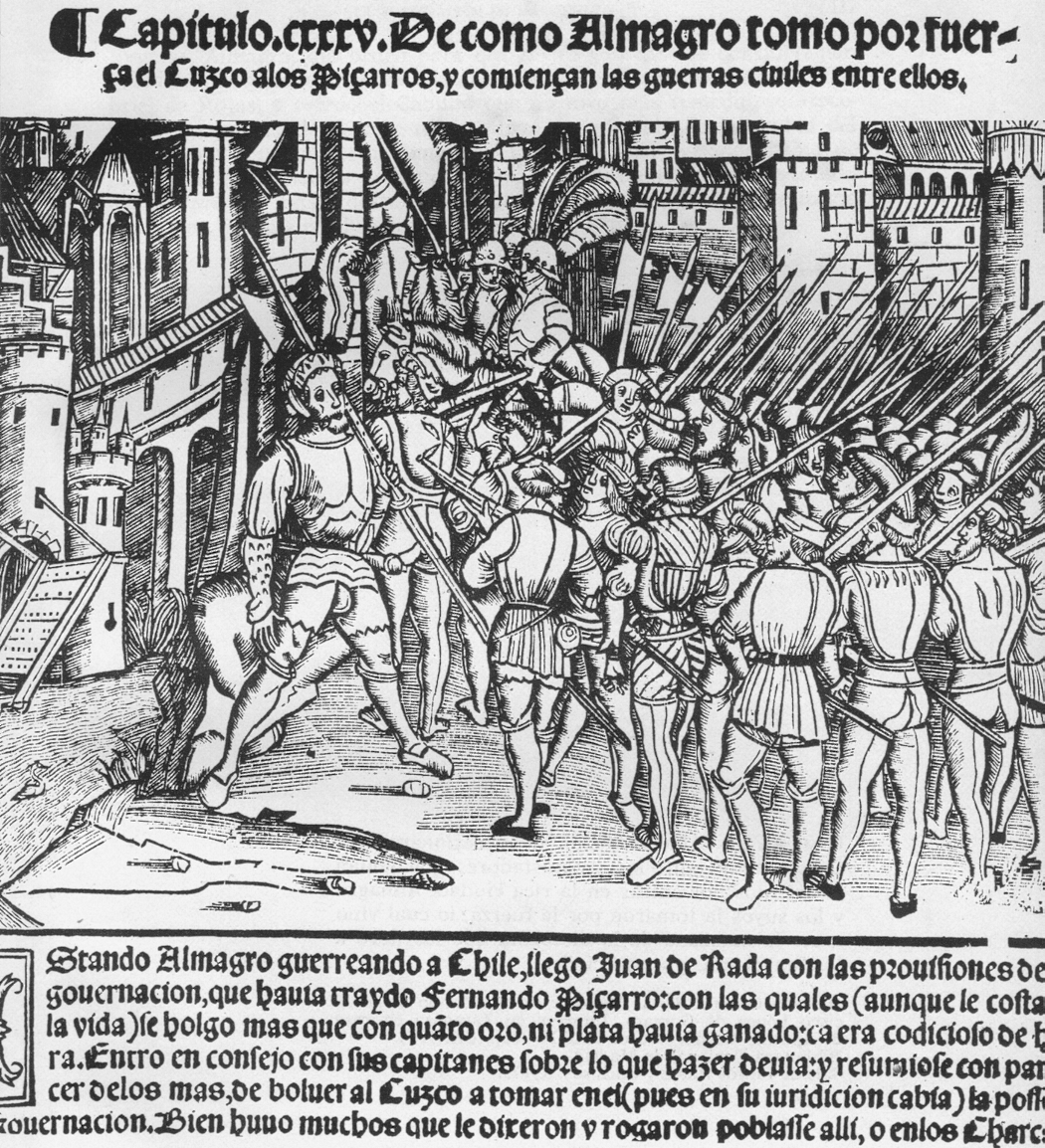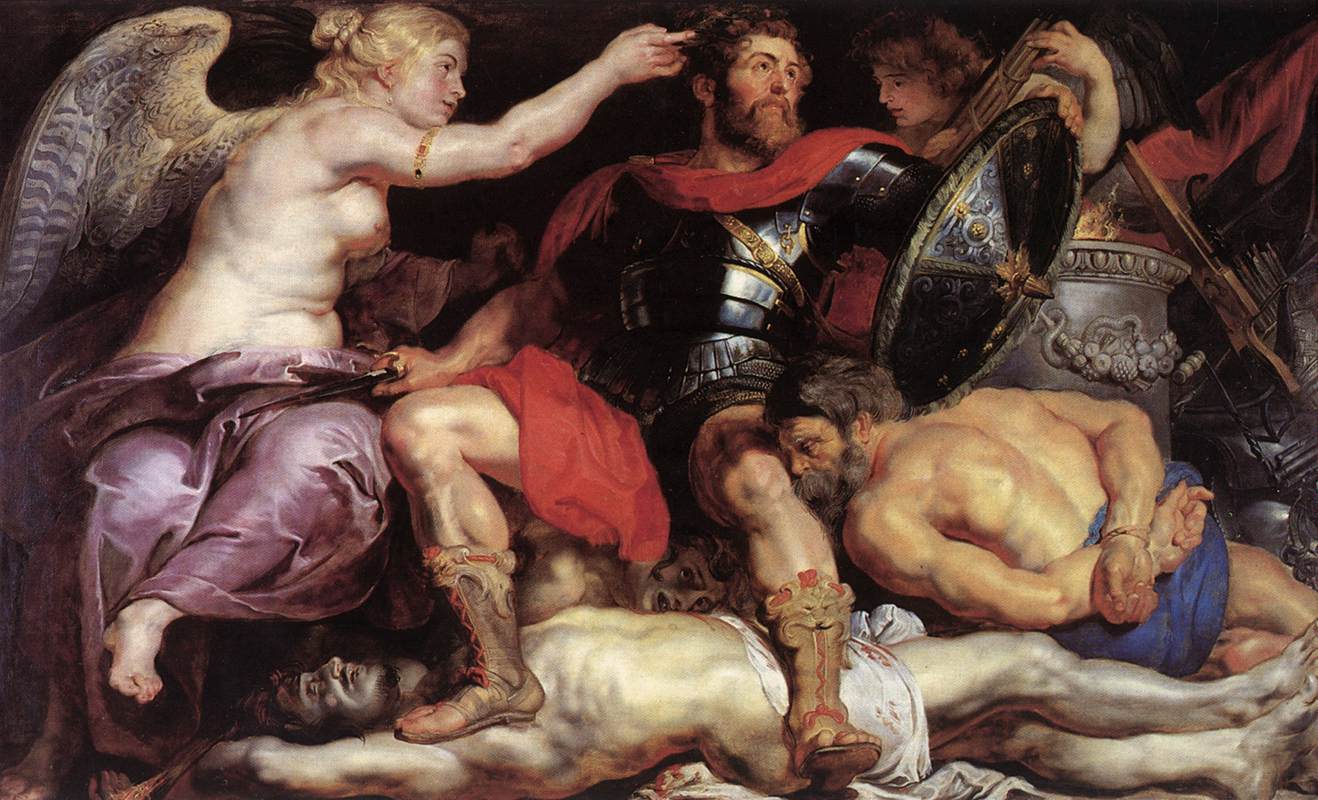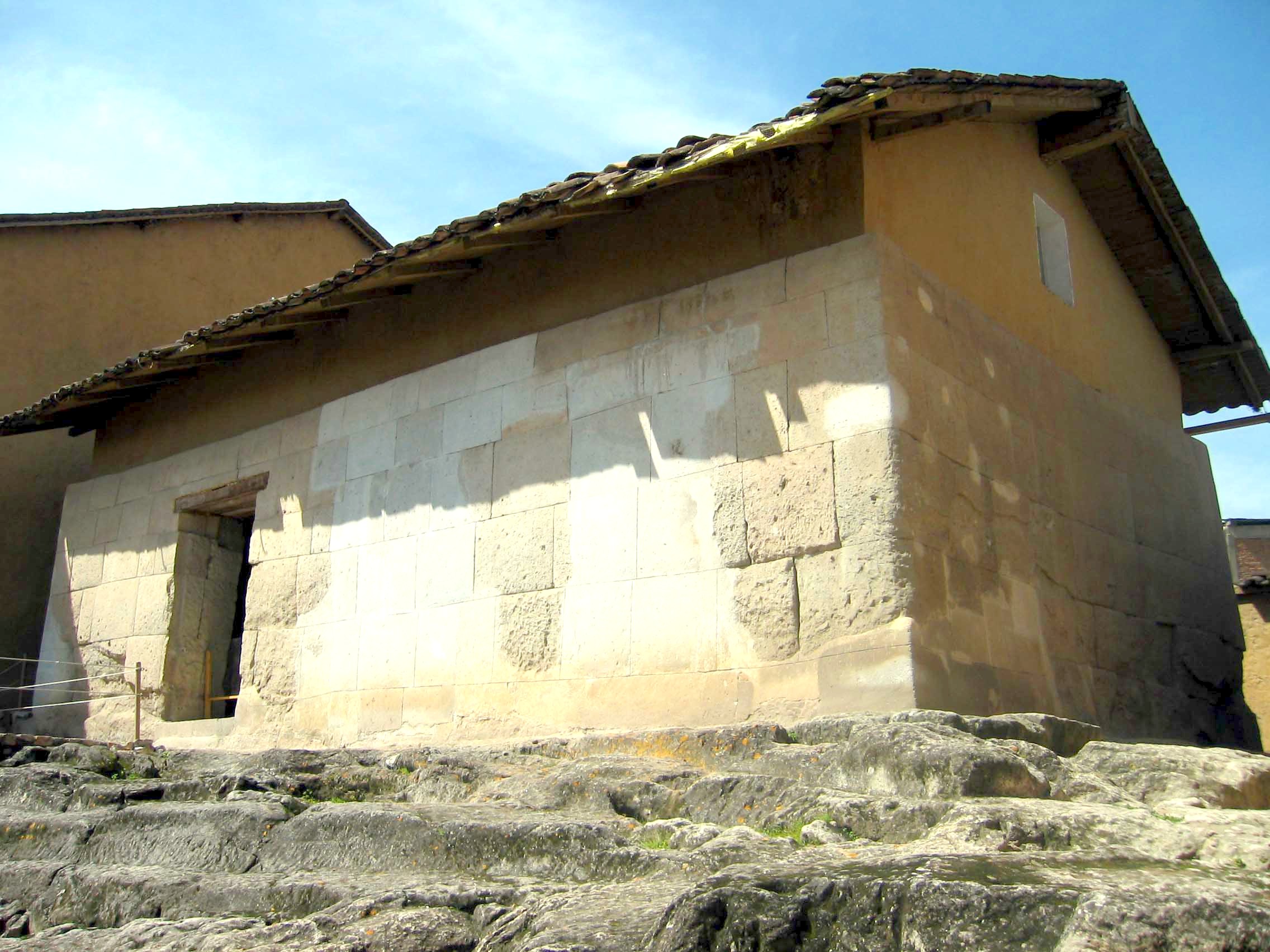|
Siege Of Cusco
The 10-month siege of Cusco by the Inca army under the command of Sapa Inca Manco Inca Yupanqui started on 6 May 1536 and ended in March 1537. The city was held by a garrison of Spanish conquistadors and Indian auxiliaries led by Hernando Pizarro. The Incas hoped to restore their empire (1438–1533) with this action, but it was ultimately unsuccessful. Background Francisco Pizarro, Hernando's older brother, received chief rights of discovery and conquest in Peru, or New Castile, and the Governorship of the territory from King Charles I of Spain in the Capitulation of July 1529. Pizarro and his Spanish conquistadors invaded Peru and captured Atahualpa, the Sapa Inca, on November 16, 1532, at Cajamarca. The events at Cajamarca initiated the Spanish conquest of the Incas. The Spaniards later killed Atahualpa in July 1533, after deceptively acquiring a ransom of over of gold and silver for his release. Atahualpa's death exacerbated pre-existing dynastic rivalries for the Inca th ... [...More Info...] [...Related Items...] OR: [Wikipedia] [Google] [Baidu] |
Guaman Poma
Felipe Guamán Poma de Ayala (Fane, 165after 1616), also known as Huamán Poma or Waman Poma, was a Quechua nobleman known for chronicling and denouncing the ill treatment of the natives of the Andes by the Spanish Empire after their conquest of Peru.Adorno, RolenaFelipe Guamán Poma de Ayala's ''Nueva crónica y buen gobierno'' (''New Chronicle and Good Government'').''Early Ibero/Anglo Americanist Summit: New World Antiquities and Histories.'' (retrieved 8 Sept 2009) Today, Guaman Poma is noted for his illustrated chronicle, '' El primer nueva corónica y buen gobierno''.Fane, 166 Biography The son of a noble family of the Indigenous (but non-Inca) Yarowilca dynasty of Guánuco in the north Peruvian cordillera, he was a direct descendant of the eminent Indigenous conqueror and ruler Huaman-Chava-Ayauca Yarovilca-Huanuco.Hamilton, RolandTable of Contents and Excerpt, Guaman Poma de Ayala, the First New Chronicle and Good Government.''University of Texas Press.'' 2009 (retriev ... [...More Info...] [...Related Items...] OR: [Wikipedia] [Google] [Baidu] |
Rodrigo Orgóñez
Rodrigo Orgóñez (1490 – 26 April 1538) was a Spanish captain under Diego de Almagro, a conquistador known for his exploits in western South America. Born in Oropesa, Rodrigo participated in the Italian Campaigns. He accompanied Francisco de Godoy from Nicaragua when they joined Diego's men in reinforcing Pizarro during the Spanish conquest of the Inca Empire.Leon, P., 1998, The Discovery and Conquest of Peru, Chronicles of the New World Encounter, edited and translated by Cook and Cook, Durham: Duke University Press, He proved his loyalty serving as a soldier for 5 years before he was made second in command to conquer and govern the southern portion of the Incan Empire. He helped Almagro in his 1537 coup d'état in Cusco, leading the group that surrounded the Amaru Cancha Palace capturing Hernando Pizarro Hernando Pizarro y de Vargas (; c. 1504 – c. 1578) was a Spanish conquistador and one of the Pizarro brothers who ruled over Peru. He was the only one of the ... [...More Info...] [...Related Items...] OR: [Wikipedia] [Google] [Baidu] |
Conquest
Conquest involves the annexation or control of another entity's territory through war or Coercion (international relations), coercion. Historically, conquests occurred frequently in the international system, and there were limited normative or legal prohibitions against conquest. The onset and diffusion of nationalism (the belief that nation and state should be congruent), especially in the 19th century, made the idea of conquest increasingly unacceptable to popular opinion. Prohibitions against conquest were codified with the establishment of the League of Nations following World War I and of the United Nations at the end of World War II. Scholars have debated the strength of a Social norm, norm against conquest since 1945. Conquest of large swaths of territory has been rare since the end of World War II. However, states have continued to pursue annexation of small territories. History Military history provides many examples of conquest: the Roman conquest of Britain, the S ... [...More Info...] [...Related Items...] OR: [Wikipedia] [Google] [Baidu] |
Cajamarca
Cajamarca (), also known by the Quechua name, ''Kashamarka'', is the capital and largest city of the Cajamarca Region as well as an important cultural and commercial center in the northern Andes. It is located in the northern highlands of Peru at approximately 2,750 m (8,900 ft) above sea level in the valley of the Mashcon river. Cajamarca had an estimated population of about 226,031 inhabitants in 2015, making it the 13th largest city in Peru. Cajamarca has a mild highland climate, and the area has very fertile soil. The city is well known for its dairy products and mining activity in the surroundings. Among its tourist attractions, Cajamarca has numerous examples of Spanish colonial religious architecture, beautiful landscapes, pre-Hispanic archeological sites and hot springs at the nearby town of Baños del Inca (Baths of the Inca). The history of the city is highlighted by the Battle of Cajamarca, which marked the defeat of the Inca Empire by Spanish invader ... [...More Info...] [...Related Items...] OR: [Wikipedia] [Google] [Baidu] |
Atahualpa
Atahualpa (), also Atawallpa or Ataw Wallpa ( Quechua) ( 150226 July 1533), was the last effective Inca emperor, reigning from April 1532 until his capture and execution in July of the following year, as part of the Spanish conquest of the Inca Empire. Biography Atahualpa was the son of the emperor Huayna Cápac, who died around 1525 along with his successor, Ninan Cuyochi, in a smallpox epidemic. Atahualpa initially accepted his half-brother Huáscar as the new emperor, who in turn appointed him as governor of Quito in the north of the empire. The uneasy peace between them deteriorated over the next few years. From 1529 to 1532, they contested the succession in the Inca Civil War, in which Atahualpa's forces defeated and captured Huáscar. Around the same time as Atahualpa's victory, a group of Spanish conquistadors, led by Francisco Pizarro, arrived in the region. In November 1532, they captured Atahualpa during an ambush at Cajamarca. In captivity, Atahualpa gave a ... [...More Info...] [...Related Items...] OR: [Wikipedia] [Google] [Baidu] |
Capitulation (treaty)
A capitulation is a treaty or unilateral contract by which a sovereign state relinquishes jurisdiction within its borders over the subjects of a foreign state. As a result, the foreign subjects are immune, for most civil and criminal purposes, from actions by courts and other governmental institutions in the state that makes the capitulation. The term ''capitulation'' is derived from the Latin word ''caput''. Historical examples Medieval capitulations In the Ottoman Empire, arrangements termed Capitulations of the Ottoman Empire, capitulations, and treaties confirmatory of them were made between the Ottoman Porte, Sublime Porte and other states by which Resident alien, foreigners resident in the Administrative divisions of the Ottoman Empire, territories of the Ottoman Empire were subjected to the laws of their respective countries. In the 9th century CE, the Abbasid Caliphate, Abbasid caliph Harun al-Rashid, Hārūn al-Rashīd granted guarantees and commercial facilities to ... [...More Info...] [...Related Items...] OR: [Wikipedia] [Google] [Baidu] |
Spanish Empire
The Spanish Empire, sometimes referred to as the Hispanic Monarchy (political entity), Hispanic Monarchy or the Catholic Monarchy, was a colonial empire that existed between 1492 and 1976. In conjunction with the Portuguese Empire, it ushered in the European Age of Discovery. It achieved a global scale, controlling vast portions of the Americas, Africa, various islands in Asia and Oceania, as well as territory in other parts of Europe. It was one of the most powerful empires of the early modern period, becoming known as "the empire on which the sun never sets". At its greatest extent in the late 1700s and early 1800s, the Spanish Empire covered , making it one of the List of largest empires, largest empires in history. Beginning with the 1492 arrival of Christopher Columbus and continuing for over three centuries, the Spanish Empire would expand across the Caribbean Islands, half of South America, most of Central America and much of North America. In the beginning, Portugal was ... [...More Info...] [...Related Items...] OR: [Wikipedia] [Google] [Baidu] |
Charles V, Holy Roman Emperor
Charles V (24 February 1500 – 21 September 1558) was Holy Roman Emperor and Archduke of Austria from 1519 to 1556, King of Spain (as Charles I) from 1516 to 1556, and Lord of the Netherlands as titular Duke of Burgundy (as Charles II) from 1506 to 1555. He was heir to and then head of the rising House of Habsburg. His dominions in Europe included the Holy Roman Empire, extending from Germany to northern Italy with rule over the Austrian hereditary lands and Burgundian Low Countries, and Spain with its possessions of the southern Italian kingdoms of Naples, Sicily and Sardinia. In the Americas, he oversaw the continuation of Spanish colonization and a short-lived German colonization. The personal union of the European and American territories he ruled was the first collection of realms labelled " the empire on which the sun never sets". Charles was born in Flanders to Habsburg Archduke Philip the Handsome, son of Maximilian I, Holy Roman Emperor and Mary of Burg ... [...More Info...] [...Related Items...] OR: [Wikipedia] [Google] [Baidu] |
Francisco Pizarro
Francisco Pizarro, Marquess of the Atabillos (; ; – 26 June 1541) was a Spanish ''conquistador'', best known for his expeditions that led to the Spanish conquest of the Inca Empire. Born in Trujillo, Cáceres, Trujillo, Spain, to a poor family, Pizarro chose to pursue fortune and adventure in the New World. He went to the Gulf of Urabá, and accompanied Vasco Núñez de Balboa in his crossing of the Isthmus of Panama, where they became the first Europeans to see the Pacific Ocean from the Americas. He served as mayor of the newly founded Panama City for a few years and undertook two failed expeditions to Peru. In 1529, Pizarro obtained permission from the Monarchy of Spain, Spanish crown to lead a campaign to conquer Peru and went on his third, and successful, expedition. When local people who lived along the coast resisted this invasion, Pizarro moved inland and founded the first Spanish settlement in Peru, Piura, San Miguel de Piura. After a series of manoeuvres, Pizarro c ... [...More Info...] [...Related Items...] OR: [Wikipedia] [Google] [Baidu] |
Indian Auxiliaries
Indian auxiliaries, also known in the sources as ''Indios amigos'' (), were those indigenous peoples of the Americas who allied with Spain and fought alongside the conquistadors during the Spanish colonization of the Americas. These auxiliaries acted as guides, translators, soldiers, explorers and porters, often outnumbering peninsular Spaniards by enormous degrees in their military formations. During the Spanish conquest of the Inca Empire, indigenous assistants were referred to by the indigenous word of '' yanakuna''. Indian auxiliaries continued to be used by the Spanish to maintain control over their colonies in the Americas; frequently stationed on the frontier, they were often used to suppress anti-colonial revolts such as Arauco War. Their important role in achieving the conquests of Spain gave birth to a modern Spanish-speaking idiom, '' la conquista la hicieron los indios'' ("the Indians did the conquest"). History The formations of auxiliary Indians arose common ... [...More Info...] [...Related Items...] OR: [Wikipedia] [Google] [Baidu] |
Conquistador
Conquistadors (, ) or conquistadores (; ; ) were Spanish Empire, Spanish and Portuguese Empire, Portuguese colonizers who explored, traded with and colonized parts of the Americas, Africa, Oceania and Asia during the Age of Discovery. Sailing beyond the Iberian Peninsula, they established numerous Colony, colonies and trade routes, and brought much of the "New World" under the dominion of Spain and Portugal. After Christopher Columbus's arrival in the West Indies in 1492, the Spanish, usually led by Hidalgo (nobility), hidalgos from the west and south of Spain, began building a colonial empire in the Caribbean using colonies such as Captaincy General of Santo Domingo, Santo Domingo, Captaincy General of Cuba, Cuba, and Captaincy General of Puerto Rico, Puerto Rico as their main bases. From 1519 to 1521, Hernán Cortés led the Spanish conquest of the Aztec Empire, ruled by Moctezuma II. From the territories of the Aztec Empire, conquistadors expanded Spanish rule to northern Ce ... [...More Info...] [...Related Items...] OR: [Wikipedia] [Google] [Baidu] |
Sapa Inca
The Sapa Inca (from ; ) was the monarch of the Inca Empire (''Tawantinsuyu'' "the region of the four [provinces]"), as well as ruler of the earlier Kingdom of Cusco and the later Neo-Inca State at Vilcabamba, Peru, Vilcabamba. While the origins of the position are mythical and originate from the Origin myth, legendary foundation of the city of Cusco, it seems to have come into being historically around AD 1100. Although the Inca believed the Sapa Inca to be the son of Inti (the Solar deity, Sun god) and often referred to him as ''Inti churi'' "solar son" or ''Intip churin'' "son of the Sun", the position eventually became Hereditary monarchy, hereditary, with Primogeniture#Agnatic primogeniture, son succeeding father. The principal wife of the Inca was known as the Qoya, coya or ''quya''. The Sapa Inca was at the top of the social hierarchy, and played a dominant role in the political and spiritual realm. Manco Capac, the first Inca monarch, adopted the title ''capac'' or ''qhap ... [...More Info...] [...Related Items...] OR: [Wikipedia] [Google] [Baidu] |








